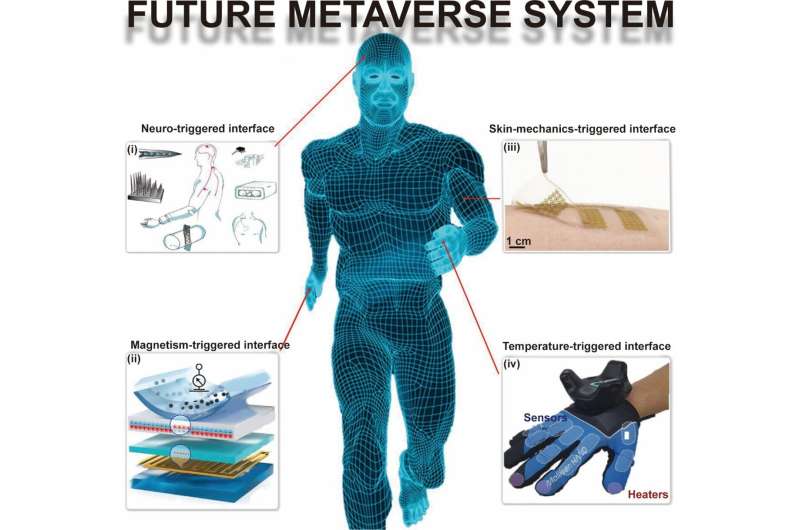This article has been reviewed according to Science X's editorial process and policies. Editors have highlighted the following attributes while ensuring the content's credibility:
fact-checked
proofread
Flexible sensors made of nanomaterials—and the metaverse—will redefine how people live in the future

Researchers from Changchun University of Science and Technology (CUST) and City University of Hong Kong (CityU) have conducted a survey on the fabrication of flexible sensors using nanomaterials of different dimensions and the triggering methods of interaction between these sensors and virtual reality applications.
The review, published in the International Journal of Extreme Manufacturing (IJEM), highlights the recent advancements in nanomaterial-based flexible sensors (NMFSs) involving various nanomaterial frameworks such as nanoparticles, nanowires, and nanofilms.
Different triggering mechanisms for interaction between NMFSs and metaverse/virtual reality applications are discussed, e.g., skin-mechanics-triggered, temperature-triggered, magnetically triggered, and neural-triggered interfaces.
In the context of interfacing physical and virtual worlds, machine learning has emerged as a promising tool for sensor data processing and controlling avatars in the metaverse/virtual reality world.
"Flexible sensors based on nanomaterials hold great promise for applications in metaverse and virtual reality technologies due to their light weight, high sensitivity, and conformality to human skin or clothes," said Wen Jung Li, a chair professor in the Dept. of Mechanical Engineering at the City University of Hong Kong and a co-corresponding author of the paper, "and they are expected to replace silicon-based rigid sensors in the future for many human-computer-interaction applications".
"The fabrication and trigger-interface methods discussed in this paper have provided me with some extremely important information on how to fabricate flexible sensors using different nanomaterials and what types of physical and physiological information can be detected for human-computer interactions," said Jianfei Wang (a Ph.D. student at the Changchun University of Science and Technology, who expects to defend his dissertation in 2024), the first author of the paper.
The research areas in his lab are mainly related to nanomaterials, and nano-handling and manufacturing technology. Hence, this review has helped him comprehensively understand research activities related to nanomaterials and virtual technology applications worldwide.
NMFSs can be tightly attached to the human skin or integrated with clothing to monitor subjects' physical and physiological information while they explore metaverse spaces. Nanomaterials have been widely incorporated into flexible sensors due to their facile processing, material compatibility, and unique properties.
Compared with traditional flexible sensors, NMFSs have the following advantages: high sensitivity, low power, malleability, reliability, and large-scale fabrication. These sensors can help VR/metaverse systems to better monitor different parts of the human body, thus, providing a smoother, more realistic immersive experience in the future.
The collaborative team formed by CUST and CityU researchers is also exploring different functional nanomaterial sensors for applications in virtual reality.
"We believe that future developments in VR sensing using flexible sensors will make the virtual reality experience much more realistic, immersive, and natural, providing users with a realistic experience of their living environment and working atmosphere. We are working on nanomaterial flexible sensors for sensing skin vibrations, facial expressions, muscle activities, limb motions, etc.," said Professor Li.
More information: Jianfei Wang et al, Nanomaterial-based flexible sensors for metaverse and virtual reality applications, International Journal of Extreme Manufacturing (2023). DOI: 10.1088/2631-7990/acded1




















